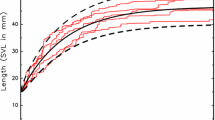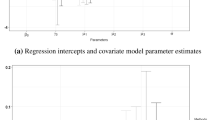Abstract
The direct estimation and modeling of population growth rate from capture–recapture data has now seen a number of applications. However, the original model cannot accommodate heterogeneous capture probabilities. While studying a population of small mammals Peromyscus maniculatus, we became concerned that the peak of population size may be estimated too late in the year because of heterogeneous catchability. Hence, we developed a variation of the original model with a finite number of catchability classes. The results obtained with the new model are more in agreement with the known biology of this population. A bibliographic appendix and computer code are available online.
Similar content being viewed by others
References
Anthony, R. G., Forsman, E. D., Franklin, A. B., Anderson, D. R., Burnham, K. P., White, G. C., Schwarz, C. J., Nichols, J. D., Hines, J. E., Olson, G. S., Ackers, S. H., Andrews, L. S., Biswell, B. L., Carlson, P. C., Diller, L. V., Dugger, K. M., Fehring, K. E., Fleming, T. L., Gerhardt, R. P., Gremel, S. A., Gutierrez, R. J., Happe, P. J., Herter, D. R., Higley, J. M., Horn, R. B., Irwin, L. L., Loschl, P. J., Reid, J. A., and Sovern, S. G. (2006), “Status and Trends in Demography of Northern Spotted Owls, 1985–2003,” Wildlife Monographs, 163, 1–48.
Carothers, A. (1973), “The Effects of Unequal Catchability on Jolly–Seber Estimates,” Biometrics, 29, 79–100.
— (1979), “Quantifying Unequal Catchability and Its Effects on Survival Estimates in an Actual Population,” Journal of Animal Ecology, 48, 863–869.
Caswell, H. (2001), Matrix Population Models: Construction, Analysis and Interpretation (2nd ed.), Sunderland, MA: Sinauer Associates.
Choquet, R., Lebreton, J.-D., Gimenez, O., Reboulet, A.-M., and Pradel, R. (2009), “U-CARE: Utilities for Performing Goodness of Fit Tests and Manipulating CApture–REcapture Data,” Ecography, in press.
Courtney, S., Blakesley, J., Bigley, R., Cody, M., Dumbacher, J., Fleischer, R., Franklin, A. B., Franklin, J., Gutiérrez, R., Marzluff, J., and Sztukowski, L. (2004), “Scientific Evaluation of the Status of the Northern Spotted Owl, ” scientific report, Sustainable Ecosystems Institute, Portland, OR.
Crespin, L., Choquet, R., Lima, M. A., Merritt, J. F., and Pradel, R. (2008), “Is Heterogeneity of Catchability in Capture–Recapture Studies a Mere Sampling Artifact or a Biologically Relevant Feature of the Population?” Population Ecology, 50, 247–256.
Efford, M. (1998), “Demographic Consequences of Sex-Biased Dispersal in a Population of Brushtail Possums,” Journal of Animal Ecology, 67, 503–517.
Franklin, A. B., Burnham, K. P., White, G. C., Anthony, R. G., Forsman, E. D., Schwarz, C., Nichols, J. D., and Hines, J. E. (1999), Range-Wide Status and Trends in Northern Spotted Owl Populations, Portland, OR: U.S. Fish and Wildlife Service.
Franklin, A. B., Gutiérrez, R. J., Nichols, J. D., Seamans, M. E., White, G. C., Zimmerman, G. S., Hines, J. E., Munton, T. E., LaHaye, W. S., Blakesley, J. A., Steger, G. N., Noon, B. R., Shaw, D. W. H., Keane, J. J., McDonald, T. L., and Susan, B. (2004), “Population Dynamics of the California Spotted Owl (Strix occidentalis occidentalis): A Meta-Analysis,” Ornithological Monographs, 54, 1–110.
Hammond, E. L., and Anthony, R. G. (2006), “Mark–Recapture Estimates of Population Parameters for Selected Species of Small Mammals,” Journal of Mammalogy, 87, 618–627.
Hines, J. E., and Nichols, J. D. (2002), “Investigations of Potential Bias in the Estimation of Lambda Using Pradel’s (1996) Model for Capture–Recapture Data,” Journal of Applied Statistics, 29, 573–587.
Jolly, G. (1965), “Explicit Estimates From Capture–Recapture Data With Both Death and Immigration-Stochastic Model,” Biometrika, 52, 225–247.
Link, W. A. (2003), “Nonidentifiability of Population Size From Capture–Recapture Data With Heterogeneous Detection Probabilities,” Biometrics, 59, 1123–1130.
Marchand, P. J. (1996), Life in the Cold: An Introduction to Winter Ecology, Lebanon, NH: University Press of New England.
Merritt, J. F. (1984), “Growth Patterns and Seasonal Thermogenesis of Clethrionomys gapperi Inhabiting the Appalachian and Rocky Mountains of North America,” in Winter Ecology of Small Mammals, ed. J. F. Merritt, Pittsburg, PA: Carnegie Museum of Natural History, pp. 201–213.
— (1987), Guide to the Mammals of Pennsylvania, Pittsburgh, PA: University of Pittsburgh Press.
Merritt, J. F., and Merritt, J. M. (1980), “Population Ecology of the Deer Mouse (Peromyscus maniculatus) in the Front Range of Colorado,” Annals of Carnegie Museum, 49, 113–130.
Ostfeld, R. S., and Canham, C. D. (1995), “Density-Dependent Processes in Meadow Voles, an Experimental Approach,” Ecology, 76, 521–532.
Pledger, S. (2000), “Unified Maximum Likelihood Estimates for Closed Capture–Recapture Models Using Mixtures,” Biometrics, 56, 434–442.
Pledger, S., Pollock, K. H., and Norris, J. L. (2003), “Open Capture–Recapture Models With Heterogeneity: I. Cormack–Jolly–Seber Model,” Biometrics, 59, 786–794.
Pollock, K. H., Hines, J. E., and Nichols, J. D. (1985), “Goodness-of-Fit Tests for Open Capture–Recapture Models,” Biometrics, 41, 399–410.
Pradel, R. (1993), “Flexibility in Survival Analysis From Recapture Data: Handling Trap-Dependence,” in Marked Individuals in the Study of Bird Population, eds. J.-D. Lebreton and P. M. North, Basel, Switzerland: Birkhaüser, pp. 29–37.
— (1996), “Utilization of Capture–Mark–Recapture for the Study of Recruitment and Population Growth Rate,” Biometrics, 52, 703–709.
— (2005), “Multievent: An Extension of Multistate Capture–Recapture Models to Uncertain States,” Biometrics, 61, 442–447.
— (2009), “The Stakes of Capture–Recapture Models With State Uncertainty,” in Modeling Demographic Processes in Marked Populations. Environmental and Ecological Statistics Series, Vol. 3, eds. D. L. Thomson, E. G. Cooch, and M. J. Conroy, Berlin: Springer, pp. 781–795.
Pradel, R., and Henry, P.-Y. (2007), “Potential Contributions of Capture–Recapture to the Estimation of Population Growth Rate in Restoration Projects,” Ecoscience, 14, 432–439.
Pradel, R., Hines, J. E., Lebreton, J.-D., and Nichols, J. D. (1997), “Capture–Recapture Survival Models Taking Account of Transients,” Biometrics, 53, 60–72.
Rotella, J. J., and Hines, J. E. (2005), “Effects of Tag Loss on Direct Estimates of Population Growth Rate,” Ecology, 86, 821–827.
Sandercock, B. K. (2006), “Estimation of Demographic Parameters From Live-Encounter Data: A Summary Review,” Journal of Wildlife Management, 70, 1504–1520.
Seber, G. (1965), “A Note on the Multiple-Recapture Census,” Biometrika, 52, 249–259.
Author information
Authors and Affiliations
Corresponding author
Rights and permissions
About this article
Cite this article
Pradel, R., Choquet, R., Lima, M.A. et al. Estimating Population Growth Rate From Capture–Recapture Data in Presence of Capture Heterogeneity. JABES 15, 248–258 (2010). https://doi.org/10.1007/s13253-009-0008-8
Received:
Revised:
Published:
Issue Date:
DOI: https://doi.org/10.1007/s13253-009-0008-8




